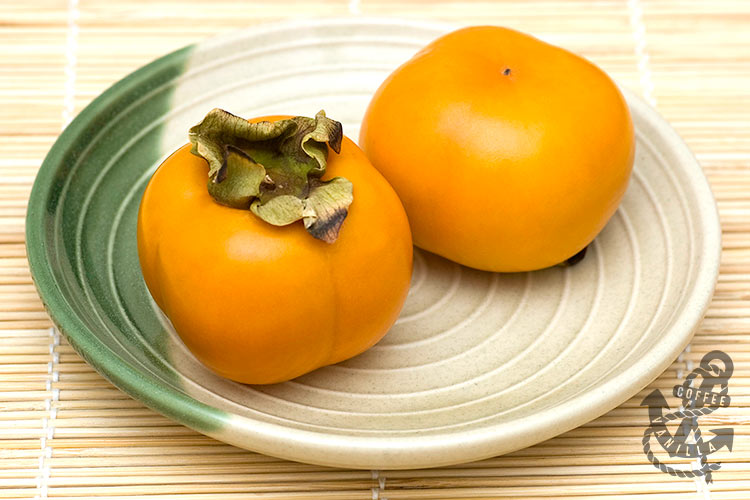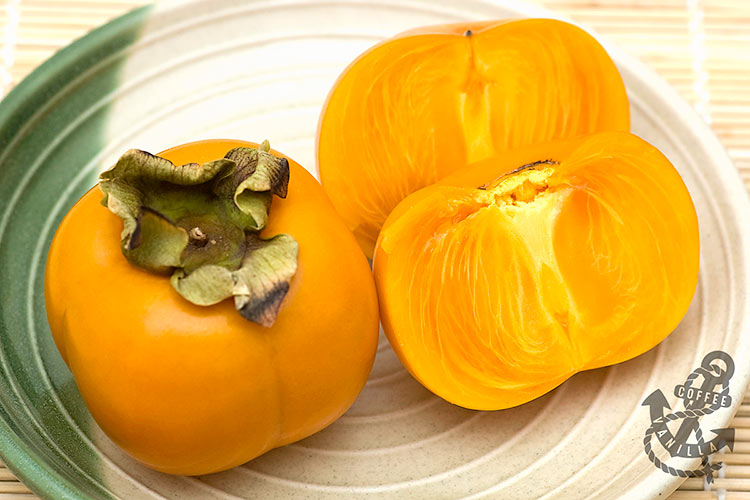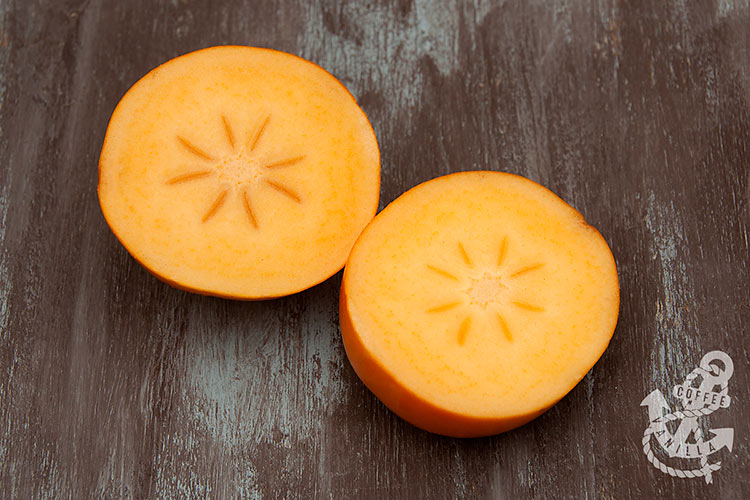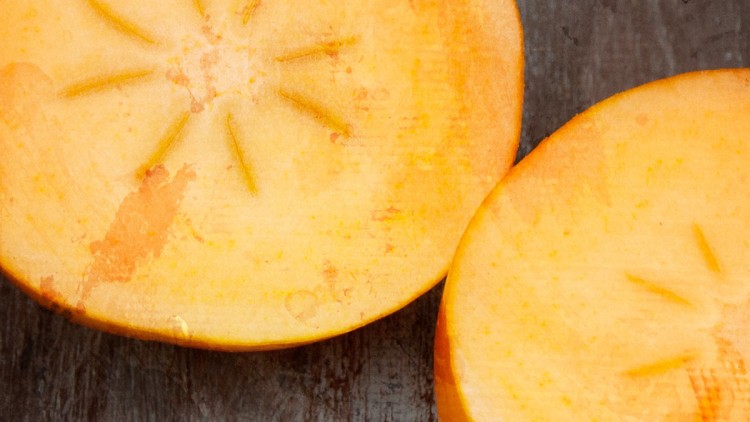Persimmons are light yellow – orange to dark red – orange in color fruits with hard, crunchy, similar to date, edible skin. Their flesh is very sweet, soft and its fibrous texture resembles a little bit pear and plum. They can be eaten raw, dried or cooked.

The most widely cultivated species is the Japanese Kaki Persimmon or Kaki (Diospyros kaki), called “shizi” in Chinese. This species, native to China. Cultivation of the fruit extended first to other parts of east Asia, and was later introduced to California and southern Europe in the 1800s. It is edible in its crisp firm state, but has its best flavor when allowed to rest and soften slightly after harvest. The Japanese cultivar ‘Hachiya’ is a widely grown cultivar. The fruit has a high tannin content which makes the immature fruit astringent and bitter. The tannin levels are reduced as the fruit matures. Persimmons like ‘Hachiya’ must be completely ripened before consumption. When ripe, this fruit comprises thick pulpy jelly encased in a waxy thin skinned shell. Sharon Fruit (named originally after Sharon Plain in Israel) is the trade name for D. kaki fruit that has been artificially ripened.

The American persimmon (Diospyros virginiana) is native to the eastern United States.
The Black Persimmon or Black Sapote (Diospyros digyna) is native to Mexico. Its fruit has green skin and white flesh, which turns black when ripe.
The Mabolo or Velvet-apple (Diospyros discolor) is native to the Philippines. It is bright red when ripe.
The Date-Plum (Diospyros lotus) is native to southwest Asia and southeast Europe. It was known to the ancient Greeks as “the fruit of the Gods”, i.e. Dios pyros (lit. “the wheat of Zeus”). Its English name probably derives from Persian Khormaloo – literally “Date-Plum”, referring to the taste of this fruit which is a reminiscent of both plums and dates. This species is mentioned in the Odyssey; it was so delicious that those who ate it forgot about returning home and wanted to stay and eat lotus with the lotus-eaters.
Spanish Persimon® Rojo Brillante variety is more orange than yellow, it seems also bigger and sweeter to other ones we have tried previously.

There are many other species of persimmon that are inedible to humans, and thus have little or no commercial value for their fruit.
NOTES
Most information source: Wikipedia.
Photo of the Rojo Brillante variety has been featured first on Coffee & Vanilla as a part of Tried & Tested series.

The Black Sapote is probably the complex fruit of all and the potential remains undiscovered by most of the world. We make a port style wine from it which two years ago won a Gold Medal at a national Australian wine show. It was also the Champion Wine of the show. The flavours as a port include Chocolate, Licorice, Dates, Prunes, Malt (Americans, think Maple Syrup), Aniseed, Sarsaparilla, Raisins, Treacle (Americans, think Maple Syrup), Figs, Vanilla, Caramel, Molasses, Black Muscat Grapes, English Christmas Pudding (Americans will have to just drool). All from a fruit that doesn’t have a flavour or an aroma.
Locally (in Tropical North Queensland) people will mix it with Ice Cream, Cakes, Puddings and Trifles, it then develops flavours of chocolate, hense the name Chocolate Pudding Fruit. It also looks like Choclate Pudding.
Cheers,
Tony Woodall. Shannonvale Tropical Fruit Winery
I love Persimmons. :) However my sis didn’t like it – for her, it tastes like soap. :p
I’ve only had luck with hachiyas in my neck of the woods, but man oh man, when those are available, I’ll be eating at least one a day. Persimmons are my absolute favorite fruit!
I have never tried these Margot and what a very informative post – many thanks for sharing this with us :D
Rosie x
Jadalam te owoce w Grecji.Jeden z moich kolegow mial drzewka w ogrodzie.Vasilis opowiedzial mi legende zwiazana z Loto ( bo tak je nazywali) W starozytnej Grecji kazdy kto zjadl ” loto-owoc zapomnienia” juz nie wracal do domu.Zapominal o dotychczasowym zyciu i zaczynal nowe.:-)
oOoOo .wlasnie doczytalam Twoj opis do tego owoca i zgadza sie z moim .A wiec niechcacy sie powtorzylam
Monika, jesli to prawda, to warto o tym pamietac, w razie czego ;)
Cool post! Who knew?!
I don’t have sweet tooth so I don’t go ga-ga over persimmons. But my mum loves it so much!! Interesting to read so many different species :)
I have never had one of these – often see them but never now what the heck I’m going to do with them… so I don’t buy them. Beautiful photo, by the way!
I have tried them as dried fruits today and they are lovely. Always had it as fresh fruit and they are lovely fruit. Never eat it when still hard, persimmon should be eaten as ripe as possible when they turn ripe as a soft tomato otherwise it will make your palate numb and leave a horrible aftertaste.
Thank you sooo much for all the comments!
Dany – I have never tried them as dried fruits yet, but I will keep my eyes open, thank you for sharing this info.